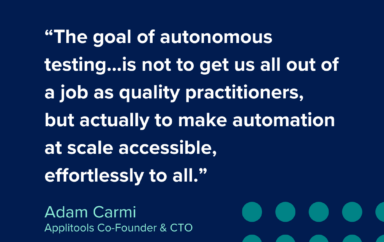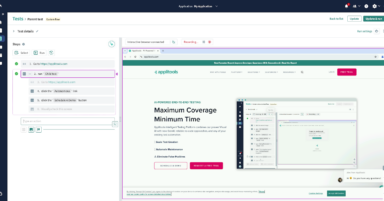The demand for high-quality software in the fast-paced tech environment has never been greater. Since companies spend more on QA to make sure their products are not buggy and look good, traditional testing is not enough. Test cases are manual and take time, automation also has its limits, especially when it comes to user interfaces with complex and fast-changing elements. AI-driven software testing comes into play, in this case revolutionizing the way quality is ensured.
Applitools Autonomous is a leading AI-based testing platform that reduces the time and effort required to create, maintain, and run tests. The most effective way of using it is as a tool in visual and functional testing and a valid scalable solution for contemporary applications.
In this blog, we will explore AI-driven testing, what are the challenges of testing modern applications, and how an AI-powered testing tool, like Applitools Autonomous, is helpful in testing applications.
About AI-Driven Testing
The phrase “AI-driven testing” describes the usage of artificial intelligence techniques to help the software testing process. Organizations can leverage machine learning, natural language processing, and other types of artificial intelligence technologies to streamline their testing processes, saving time and resources and optimizing the delivery of high-quality software.
AI-Driven Testing Key Concepts
Automation of Test Creation
The manual script writing of traditional testing can be slow, and prone to errors. This is automated with AI-driven testing in which test cases are automatically generated from the application’s structure, user flows, and user behaviors. For example, Applitools Autonomous can scan an application’s sitemap and spin up comprehensive test suites without you having to do any manual input.
Visual Validation
Visual validation is the strong point of AI-driven testing, making sure the UI functions and looks good on every device and browser. AI can also detect visual discrepancies and changes to the UI that certainly wouldn’t be picked up by standard testing methods.
Dynamic Test Maintenance
Test cases inevitably grow outdated, and applications are always in flux—that can mean a lot of work to keep them up to date. Testing platforms driven by artificial intelligence automatically adapt the tests to complement changes within the application’s UI or functionality. It reduces the burden of maintenance for QA teams and keeps testing relevant and efficient.
Predictive Analytics
Because AI can analyze historical test data to predict potential problem areas in an application, teams can concentrate their testing resources on applications’ high-risk areas. This predictive ability helps an organization’s resources get allocated better and cuts down on the likelihood of critical bugs slipping through the cracks.
Natural Language Processing (NLP)
NLP is often part of AI-driven testing tools that enable users to create test cases based on plain language text. This feature makes it easier to test so that non-technical team members can collaborate on testing with technical team members.
Challenges In Testing Modern Applications
Below are some of the challenges that we often face while testing modern applications.
Too Many Scenarios
Modern applications are highly complex, with hundreds of end-to-end scenarios that need to be tested across a vast array of screens, devices, and browsers.
Too Many Screens & Devices
In Modern applications, users access digital content on a wide variety of devices, browsers, and screen sizes, each with its own unique characteristics. Manually verifying that an application looks and functions correctly across all these environments is nearly impossible without automated assistance. Traditional testing methods cannot scale to meet this demand, often resulting in inconsistent user experiences and missed visual bugs.
Constant UI Changes
In dynamic development environments, user interfaces (UIs) are constantly evolving. Even minor changes to the UI can require updates to test scripts. This constant maintenance burden can slow down the development process and lead to outdated or ineffective tests.
Different Skill Sets
Teams often consist of members with varying technical skills, leading to the use of different tools and approaches to testing. This creates silos within the organization, where engineers and non-technical testers might not collaborate effectively.
So far we have seen the challenges in testing modern applications. Now let’s see how we can leverage AI to take over the heavy lifting in testing using Applitools Autonomous.
About Applitools Autonomous
Before we dive into Applitools Autonomous, it’s important to understand what autonomous testing is. Let’s use a car analogy to differentiate between manual, automated, and autonomous testing.
Manual testing is like driving a car with a manual transmission, where the driver is fully engaged in controlling the accelerator, brake, and clutch. Every action requires constant attention and input from the driver.
Automated testing, on the other hand, is like driving a car with an automatic transmission. While the clutch is handled automatically, the driver still needs to manage the accelerator, brake, steering wheel, etc. It reduces the manual effort but still requires active engagement.
Autonomous testing is like a self-driving car. Here, you just input your destination, and the car takes over, driving you to your destination while you focus on other things. Similarly, autonomous testing aims to eliminate human intervention, but we’re not fully there just yet. Just like self-driving cars are still evolving, fully autonomous testing is a future goal we are working towards.
Applitools Autonomous With AI
Applitools Autonomous revolutionizes the testing process by bringing the intelligence and precision of top QA professionals to an unprecedented scale through AI.
As the first autonomous testing platform, Applitools Autonomous lightens the load on your development team by automating the entire testing lifecycle—from test creation and execution to maintenance and reporting.
Applitools Autonomous is an autonomous testing platform designed to automate and enhance the entire software testing process.
Here’s a breakdown of how it works:
- Automated Test Creation: Applitools Autonomous intelligently scans your application’s sitemap to automatically generate comprehensive test cases for every URL. This ensures that your application is thoroughly tested across all pages, eliminating the need for manual test script writing.
- AI-Driven Visual Assertions: The platform applies advanced visual AI to monitor and track changes at both functional and visual levels. Whether it’s a minor UI adjustment or a significant functional update, Applitools Autonomous ensures that any deviation is detected and addressed to maintain the highest standards of user experience.
- Continuous and Scalable Testing: With Applitools Autonomous, your tests can be seamlessly integrated into your CI/CD pipeline or scheduled to run periodically. This means your application is continuously tested, providing real-time feedback and enabling faster, more reliable releases. The AI-driven approach ensures scalability, making it possible to manage even the most complex applications with ease.
- Dynamic Test Updates: As your application evolves, the platform automatically updates tests to reflect changes in the UI or functionality. This reduces the need for manual maintenance and keeps your tests relevant and effective.
- Test Results Analysis: After running tests, the platform provides detailed reports, highlighting any issues found. These reports include screenshots, logs, and other relevant data to make it easier to diagnose and fix problems.
Types of Testing with Applitools Autonomous
Applitools Autonomous allows for different types of testing, all powered by its Visual AI:
- Full Website Testing: Enter your website URL, and Applitools autonomously crawls and tests every page for both functional and visual consistency.
- Functional Testing: Ensure that user flows work as expected with AI validating both the logic and appearance of your UI elements.
- Visual Testing: Identify visual differences and UI discrepancies across devices to provide a consistent user experience.
- Regression Testing: Compare current test runs with historical data to catch any regressions introduced by new changes.
- API Testing: Automate API validation to ensure backend services work seamlessly with the UI.
Key Benefits of Applitools Autonomous and My Thoughts
Applitools Autonomous has some strong features that make it worth looking into if you’re trying to streamline your testing process. Here’s my take on the key benefits:
Automatic Test Case Generation
One thing I found impressive is how Applitools generates test cases automatically by crawling your site’s sitemap. It saves a lot of manual work, which can really make a difference when you’re managing multiple test scenarios. The fact that you can describe workflows in plain English is a nice touch, making it easier for non-technical folks to get involved.
Faster Test Creation
The speed of test creation is something that stood out to me. Applitools Autonomous claims to generate tests up to 10 times faster, and in practice, it does seem significantly quicker than traditional methods. The ability to instantly validate thousands of elements and group similar errors together really helps to keep things moving efficiently.
AI-Driven UI Validation
Visual AI is one of the more compelling features. It does a great job of catching both visual and functional issues across different devices and browsers. This kind of coverage is essential if you’re dealing with a variety of platforms and need consistent performance and appearance across all of them.
Proactive Bug Detection
I also like how you can schedule tests or integrate them into a CI/CD pipeline. This means you can catch bugs early on, which is always a plus. Dealing with issues earlier in the process tends to save time and money down the line, and the proactive nature of this feature is a big win.
Generative AI for Expanded Coverage
By scanning the root domain, Applitools builds out Visual AI scans for each page. This feature is really useful for getting broader test coverage without much manual effort, something I think teams dealing with large-scale applications will appreciate.
NLP Test Builder
The Natural Language Processing (NLP) test builder is another feature that caught my eye. It allows anyone on the team to create tests by describing steps in plain English, which makes the tool accessible to non-technical members. It definitely lowers the barrier to collaboration, which is always a plus.
Faster Test Execution
Running tests at scale can be a pain, but Applitools Autonomous handles this well with its DOM replication technology. It cuts down on test execution time, which makes it easier to test across multiple browsers and devices efficiently.
Automated Test Maintenance
One of the more practical benefits is automated test maintenance. As your UI changes, the tests update themselves, which minimizes the need for manual updates. This reduces the ongoing workload and keeps your tests relevant without constant tweaking.
Dashboards and Insights
Lastly, the dashboard is quite intuitive. It consolidates all your test results and provides a clear breakdown, making it easier to analyze outcomes and resolve issues quickly. The actionable insights offered by Applitools help speed up decision-making and improve overall application quality.
Applications Suited for Testing Using Applitools Autonomous
Applitools Autonomous is designed to enhance the testing process across a wide variety of applications, making it an ideal choice for different sectors and use cases. Here are some of the types of applications that are particularly well-suited for testing with Applitools Autonomous:
- Web Applications
Applitools Autonomous can help web applications in particular, and those with dynamic user interfaces in general, in a big way. What’s more, this platform is capable of carrying out full website tests, to ensure that not only every page on the website is working as anticipated, but the brand appears as intended across all browsers and devices.
Example: A social media platform like Facebook requires constant updates to its features and UI in some way. By automating testing, we can be sure that the user interface stays consistent across browsers and devices—e.g. post creation, messaging, and notifications—with Applitools. - Mobile Applications
Because users have access to the same application on different mobile devices, testing responsive design, testing functionality or both are absolutely necessary. The main thing that Applitools Autonomous shines at is validating mobile apps so that they always have a clear, smooth experience across various screen sizes and orientations.
Example: Instagram is dependent on visual appearance and relies on mobile applications. Applitools Autonomous is able to validate that images load correctly (or the user interface adapts to different devices) and that the app’s functionality is still in check after an update. - Ecommerce Platforms
Ecommerce applications need to be very well tested to make sure a user can smoothly navigate around, make purchases, and get correct information. The Applitools Autonomous engine can be expanded to verify the visual aspects of the platform and the functional flows (e.g. shopping cart, payment process…) as well.
Example: There are several features that Amazon has to validate: product search, shopping cart functionality, and payment process. Using Applitools we can address these problems by automating the visual and functional testing of all elements to make sure that everything does work seamlessly and the users all get a consistent user experience across different devices. - SaaS Products
Examples of software as a service (SaaS) applications are constantly delivering new features and enhancements. Autonomous from Applitools helps you make sure existing functionality does not break while validating the user interface against any visual differences in a regression backlog.
Example: CRM tools such as Salesforce are always busy introducing new features. Applitools Autonomous can run regression tests that run automatically to verify that new updates do not break existing functionalities and that the user interface is still friendly for the user. - Healthcare Applications
In the healthcare sector, applications must be user-friendly and reliable. Applitools Autonomous can validate that interfaces are intuitive and that crucial functionalities, such as patient records or appointment scheduling, work without issues.
Example: Applitools Autonomous ensures that crucial functionalities, such as appointment scheduling and medical record access, are tested for both usability and visual consistency.
Conclusion
In a rapidly evolving tech landscape, the need for high-quality software has become paramount. As traditional testing methods struggle to keep pace with the increasing complexity of applications, AI-driven testing solutions like Applitools Autonomous emerge as game-changers. This platform not only streamlines the testing process through automation but also enhances the quality of software by leveraging advanced AI techniques.
About the Author
Kailash Pathak (Applitools Ambassador | Cypress Ambassador)
Senior QA Lead Manager with over 15 years of experience in QA engineering and automation. Kailash holds certifications including PMI-ACP®, ITIL®, PRINCE2 Practitioner®, ISTQB, and AWS (CFL).
As an active speaker and workshop conductor, he shares his expertise through blogs on platforms like Medium, Dzone, LambdaTest, Talent500, The Test Tribe, and his personal site https://qaautomationlabs.com/




